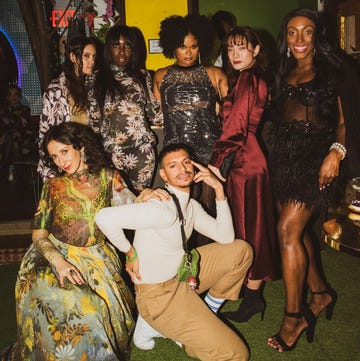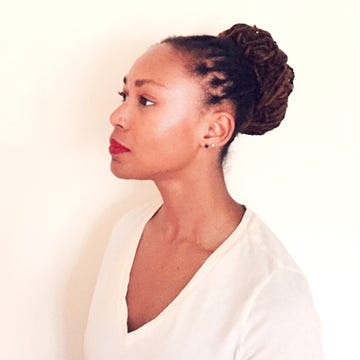“Where’s Miles?” After observing The Embrace, a mesmerizing piece of performance art in which two strangers enclosed in a glass cube sit atop a large stone caressing for six-plus hours, I decide it’s finally time to introduce myself to the work’s mastermind, Miles Greenberg.
“Miles is in the cube,” says the PR representative for Copenhagen-based Faurschou's New York exhibition space in Greenpoint, Brooklyn, where the performance is occurring alongside works by Yoko Ono and Louise Bourgeois. Puzzled, as moments before I saw the artist mingling and proudly snapping pictures of the performance, I retreat back to the darkly lit room. Stepping closer to the cube still inhabited by one of the original performers, I now find myself face-to-face with the nearly naked Greenberg, who, donning ghostly, pupil-less lenses, seemingly gazes into my soul.
A few days after his exhibition’s opening night, Greenberg and I pick up the conversation via Zoom, where I learn that when one of the performers began feeling unwell, the artist unexpectedly reprised his role. “I did 12 push-ups, put on the underwear, spritzed my face with water, and jumped in,” he says, explaining how for him, the exhibition space doubles as his studio. “You can concretize the work as much as you want, but when it comes to the live medium, there’s always space for serendipity.”
More From Harper's BAZAAR

At just 25, Greenberg has rapidly become the face of performance art for a new generation. In addition to being named in Forbes’s 2023 30 Under 30 list in the Art & Style category, this year the Montreal-born, New York–based artist has performed at New York’s Pace gallery and New Museum, not to mention the Louvre in Paris. Specializing in daring site-specific projects that unfold over the course of hours, Greenberg considers the body his medium of choice. He often immortalizes his performances in video and sculpture works, yet nothing can compare to the experience of witnessing them in person.
“The door of an exhibition space should be like a neat switch into another universe,” Greenberg says on his desire to create atmospheres that encourage his audiences to “tap into their own sensibilities more profoundly.” Having grown up on World of Warcraft, like countless millennials and Gen Zers, Greenberg strives for his exhibitions to be multi-sensory immersions where time seems to flow differently. “What I love about video games is that you walk into a space and you’re faced with a new set of rules, physiology, and physics,” he says. “You become a baby starting at level one in an environment that somebody else conceived.”
For Greenberg, every detail of the mise-en-scène is carefully considered. Lighting, scents, and soundtracks heighten the drama, while scantily clad performers (occasionally covered in paint) draw the eye to the figure. In certain instances, bodies act as natural canvases for water or bloodlike fluids to drip down. Greenberg’s long lines and conviction give his movements a balletic elegance; his undeniably gripping “stage” presence, typically amplified by the platforms and plinths on which he performs, feels theatrical in nature. Greenberg, however, is quick to distance himself from the dance and acting worlds. “I feel much closer to the way that sculptors work than the way that theater makers or choreographers work,” he says. “Flesh and blood are a sculptural medium just as much as marble. The only difference is how time acts on them.”
Semitranslucent contact lenses have become a signature of Greenberg’s. (Candy bowls full of them can be seen throughout his Chinatown apartment.) The lenses act as a barrier between the performer and the audience, significantly obscuring the performer’s vision, which appears to the viewer as an uninhabited gaze. “If you erase the eyes, the whole body becomes a shape, whereas if you reveal them, you’re looking into who is inside that body,” explains Greenberg. The idea originated from a blindfold Greenberg wore during his first-ever performance in Montreal in 2015, when he was suspended from the ceiling like a human chandelier. When eye contact is taken out of the equation, “people feel less self-conscious and step closer to the work.”
Greenberg is very much a product of his unconventional childhood, which was spent largely on tour with his mom, a first-generation Ukrainian Canadian, who was an actress in a Russian absurdist theater company based in Montreal. “I was really raised by clowns, characters, and freaks. I knew how to pull gags, like fake breaking my neck, and stage combat before I knew how to share,” recalls Greenberg, who can now speak seven languages thanks to the cast of personalities he encountered. “It was a very untraditional, fragmented, and beautiful upbringing that I wouldn’t trade for the world.”
Eventually Greenberg and his mom returned to Montreal, spending time between the city and the mountains. In 2010, a 12-year-old Greenberg accompanied his mom to New York to view the now legendary exhibition “Marina Abramović: The Artist Is Present” at MoMA. Rather than being mesmerized by the performance piece in which strangers could sit across from the motionless and silent Abramović, it was meditating on one of the artist’s “transitory objects”—specifically a wooden bed with a crystal above it—that opened Greenberg’s eyes to the power of interactive art.
By 17, Greenberg had dropped out of school, and he found himself studying Japanese butoh (a traditional form of dance theater) and performing in a variety of settings, from cabarets and drag nights to underground noise events. In 2016, Greenberg organized “Habeas Corpus,” a 10-day group show in an empty storefront that he rented on Montreal’s buzzy Saint-Lauren Boulevard. In addition to his own participation, Greenberg recruited a dozen or so performance artists to perform individual works relating to the human body. “The great thing about Montreal is it’s just metropolitan enough to have access to art and culture without necessarily having a global audience,” he says. “Had I grown up in New York or Paris, I wouldn’t have had as much freedom to experiment.”
As his desire to pursue performance art crystallized, Greenberg secured opportunities with world-renowned teachers, such as Abramović, Canadian choreographer Édouard Lock, and American director and artist Robert Wilson, who became his mentors and “North Stars.” After interning for Lock during a workshop for the Beijing Dance Academy in China, Greenberg participated in a yearlong workshop at the École International de Théâtre Jacques Lecoq in Paris, where his mom had studied theater, which instilled in him an architectural approach to the body. Following training at Red Gate Residency in Beijing and the Watermill Center in New York, Greenberg, then 20, was invited to Greece to attend Abramović’s Cleaning the House workshop, which teaches her long-duration performance method. The two have been close friends ever since.
Other influences on Greenberg range from Russian filmmaker Andrei Tarkovsky, famous for his “slow cinema,” to pioneering Japanese composer Ryuichi Sakamoto, who licensed one of his works to Greenberg for his 2023 performance at the Louvre. For Étude Pour Sébastien, Greenberg’s nearly five-hour-long nighttime performance in the museum’s illustrious halls, the artist wore black sclera lenses, full body paint, and three metal arrows, which pierced his pec, shoulder, and ribs. Greenberg’s chilling guise and poses paid homage to the Christian saint and martyr Sebastian, who was frequently depicted tied to a post and shot with arrows. “When the Louvre asks you to do something, you go hard,” says Greenberg, whose body still bears piercing scars beside marks from cupping, one of many regimens, along with infrared saunas and muscle-retraining therapy, to condition his body for performances.
Total commitment is Greenberg’s MO. His 2020 performance Oysterknife, held within Montreal’s Centre Phi and presented through the Marina Abramović Institute, entailed walking on a conveyor belt for 24 hours. At hour 18, Greenberg passed out and lost consciousness for 23 minutes, but he resumed immediately after awaking. “I completely dissociated, and I don’t really remember it, but at one point I started dancing,” says Greenberg, whose chief inspiration for the performance was a voodoo ceremony he watched while spending time in Haiti. “These practitioners put mattresses all around because over the course of the hour or so, they’re performing these acts so vigorously that they just start dropping down. The idea of devoting yourself so wholeheartedly to an idea that you’re willing to go far beyond your physical capabilities is so romantic.”
While it’s easy to fixate on the pain factor, Greenberg’s work is less about challenging the audience and himself and more about curiosity and potential. “I’m obsessed with anatomy and the dance between the sympathetic and parasympathetic nervous systems, the way our body protects us in heightened states of agony or mania and then brings us back down,” says the artist, who is also interested in how the body handles more positive sensations, like orgasm and ecstasy. With his performances, Greenberg questions what happens when the body’s “poetic rhythm” is abstracted, and these short-lived sensations are radically extended.
“The key for me is during a performance, never think about time,” says Greenberg, who goes so far as making his soundtracks loop after odd intervals (37 minutes as opposed to 30, for example) so he can’t clock how much time has elapsed. “When I’m performing, I tell myself that I need to accept whatever I’m doing in that moment as if I’m doing it for the rest of my life. It’s not about pushing and fighting. It’s about accepting and letting go. This opens your whole body up to another level of exploration.” Despite relinquishing control, Greenberg strives to maintain “just enough presence to have agency over the form, but just enough absence to let the material and the materiality of the body have its say.”
Greenberg’s self-determined ethical code is that he always performs the first of his shows: “I would never ask anybody to do anything that I’m not willing to do.” Greenberg’s recent performance at Faurschou proves he practices what he preaches. Originally performed in 2020 in Copenhagen, The Embrace was also the first performance that the artist ever sold; it was acquired by the Faurschou Foundation, which maintains a blue-chip contemporary-art collection in the Danish capital, with Beijing and New York outposts. While it’s hard to peel your eyes away from the performers’ tender exchange, another crucial component of The Embrace is seawater, 20 centimeters of which fills the cube’s base. Above the pair, an IV bag suspended from the ceiling drips river water into the cube, forming an estuary where river and ocean meet. As much as video games’ stimulating environments inspire Greenberg, so do the calmness and solitude found in nature; the artist even considers Reykjavík, Iceland, his second base.
Looking forward, Greenberg hopes to keep performing in dialogue with other artists. Prior to his intergenerational show, “Embrace the World From Within,” at Faurschou, the artist performed at Pace to complement an exhibition on the late Viennese artist Hermann Nitsch. In the coming months, he will restage a piece at the Noguchi Museum, where he will be in conversation with the American artist and architect’s works, and he will also debut a new high-fantasy performance at Powerhouse Arts. As for long-term goals, Greenberg would like to literally set himself on fire, though he admits his stuntlike, edgy ambitions come and go. “Context for me is everything,” says Greenberg. Ultimately, his eyes are set on Venice; having gone to every Venice Biennale during his lifetime (including in utero), Greenberg says his greatest wish is to represent Canada there.
Ironically, speaking his ambitions into existence scares Greenberg more than playing with fire. Living with anxiety and obsessive-compulsive disorder, he shares that he is “hyper aware of fear and death” and in a state of constant paranoia about his health. “I can be very apocalyptic in the most insignificant moments. Performing is the only space in which I feel like I have no fear,” says Greenberg, who proudly flashes his wrist, on which the words “no fear” are tattooed — a decision he made after having the worst panic attack of his life. “If I’m going to die from something stupid, it better be on stage.”

















